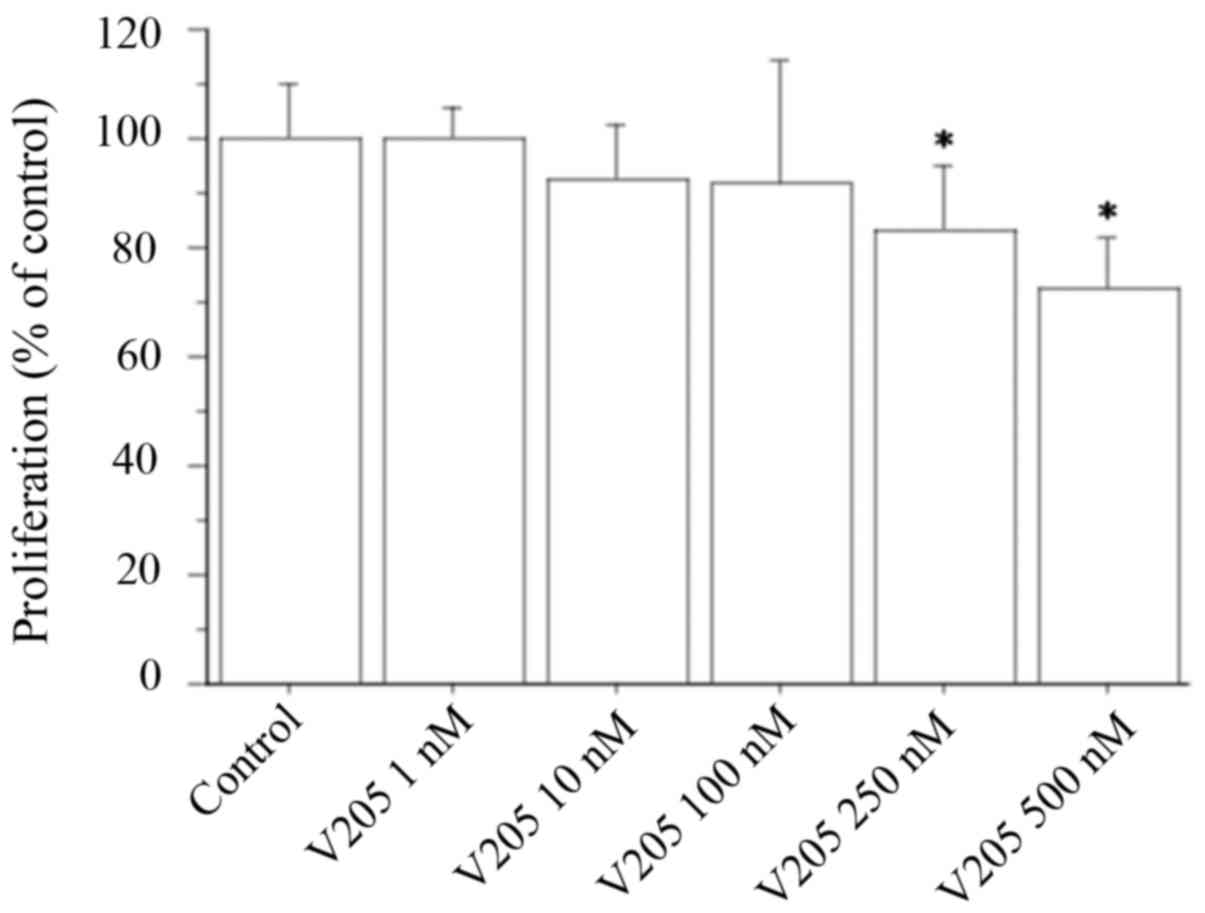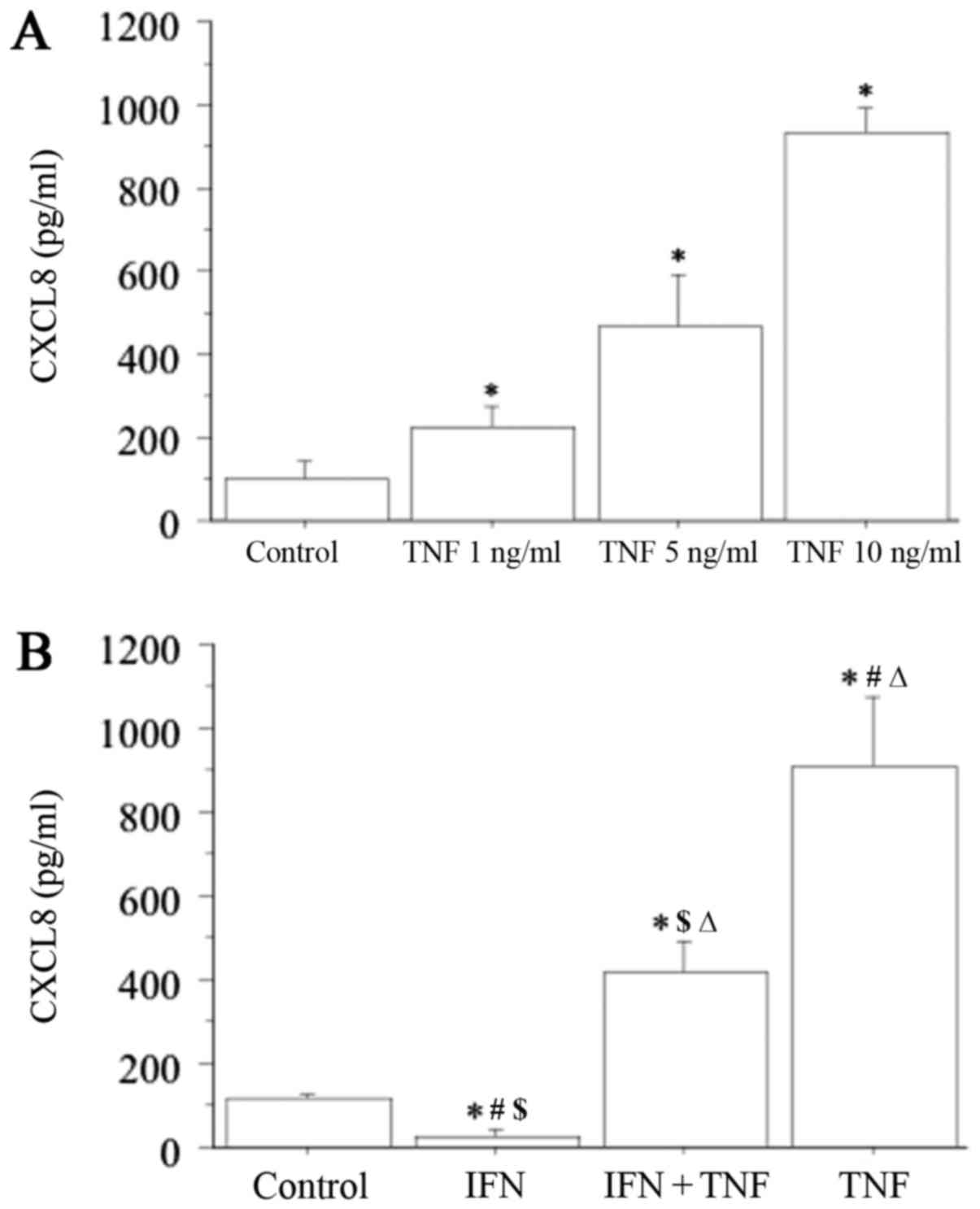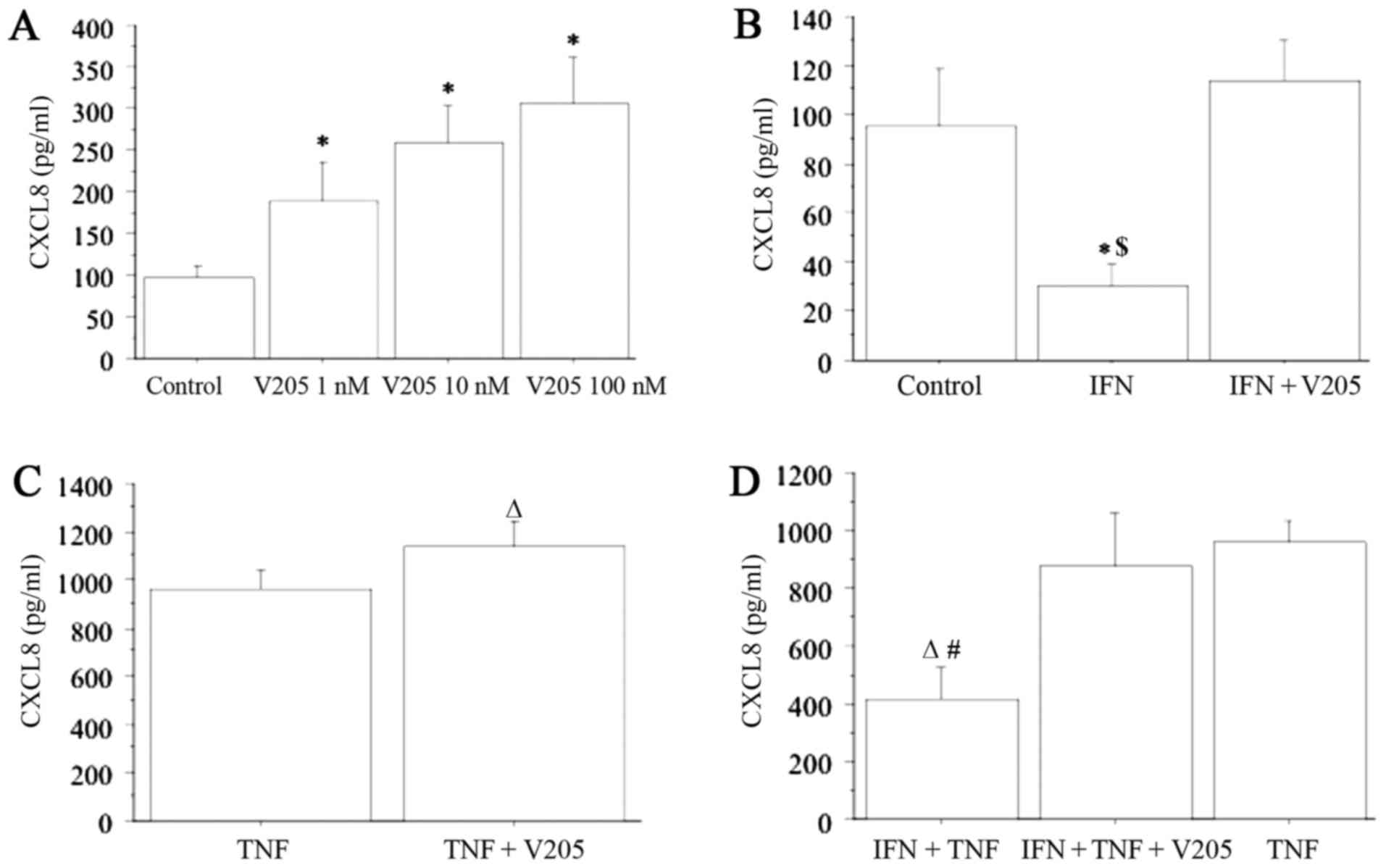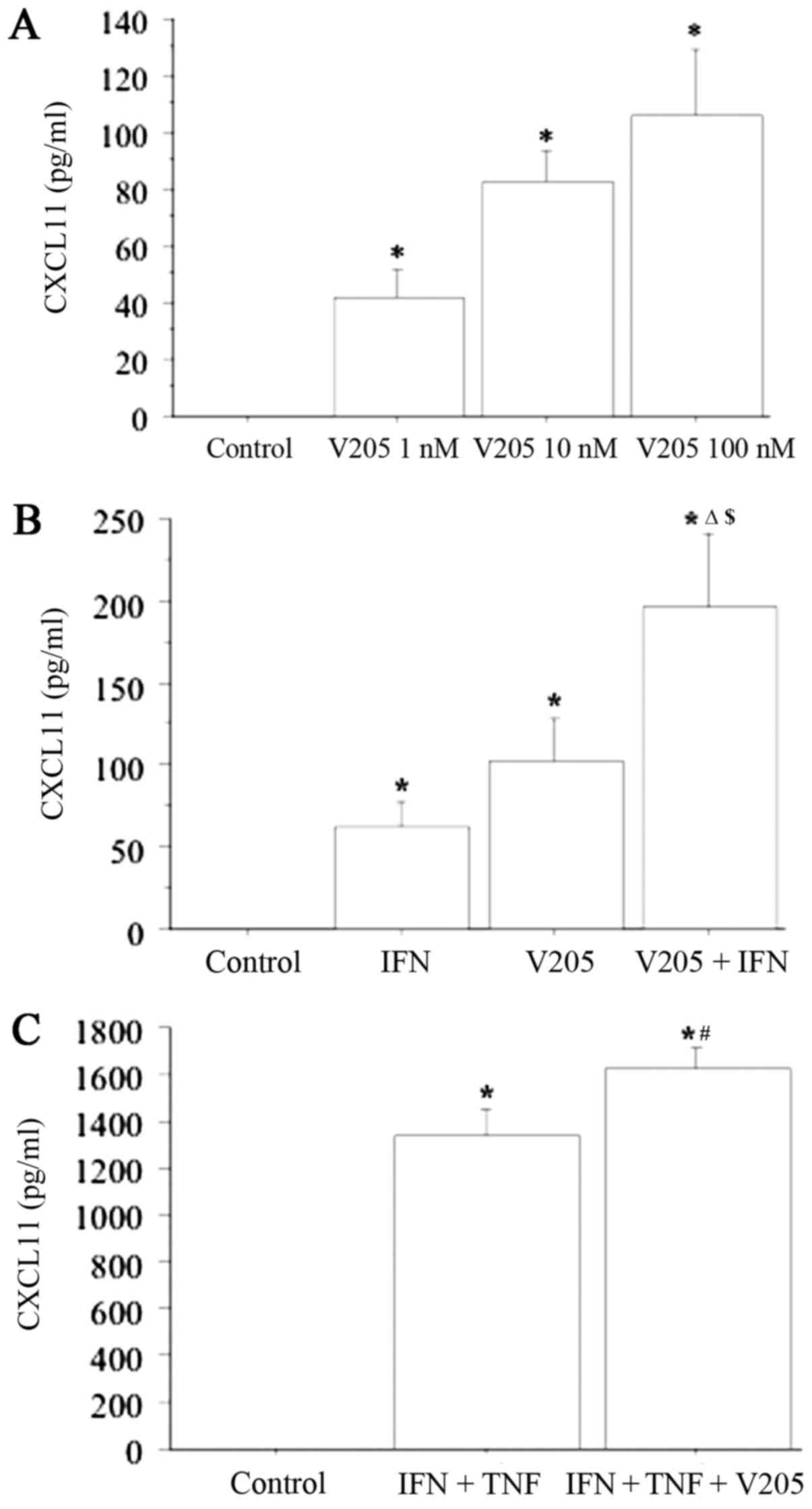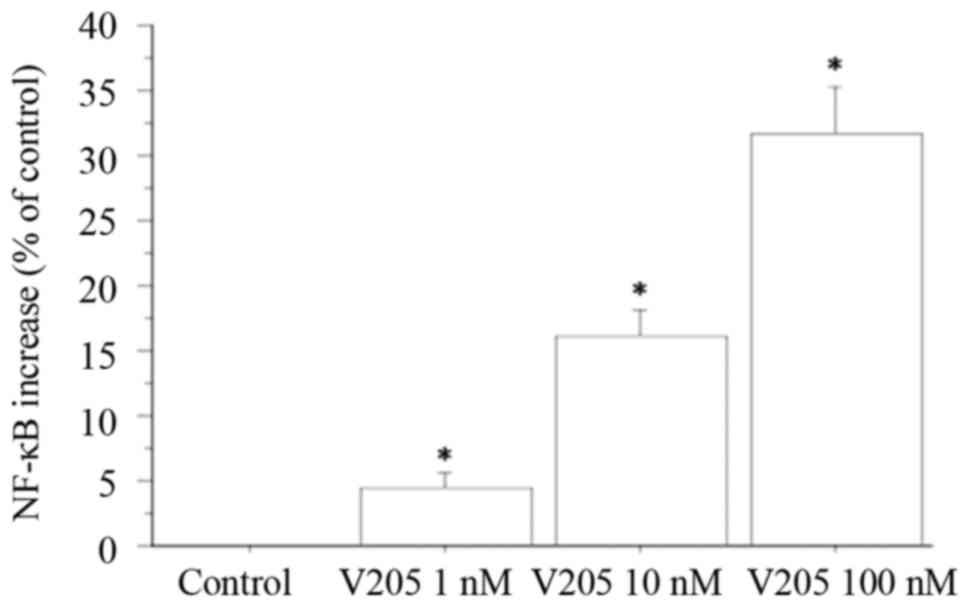Differential modulation by vanadium pentoxide of the secretion of CXCL8 and CXCL11 chemokines in thyroid cells
- Authors:
- Published online on: March 16, 2018 https://doi.org/10.3892/mmr.2018.8764
- Pages: 7415-7420
Abstract
Introduction
Vanadium pentoxide (V2O5) is the most common form of vanadium, a grey metal existing in different states of oxidation (−1, 0, +2, +3, +4, and +5). The majority of vanadium compounds are considered to be toxic.
The Occupational Safety and Health Administration (OSHA) fixed a workplace threshold for V2O5 in the air of 0.05 mg/m3 for the dust and 0.1 mg/m3 for fumes (when considering an 8 h workday/40 h work week) (1). Exposure to a 35 mg/m3 dose of vanadium it is considered dangerous and may provoke serious and perpetual health issues that can lead up to death [as established by The National Institute for Occupational Safety and Health (NIOSH)] (1). The toxic effects of vanadium mainly impact the respiratory system; effects on the gastrointestinal system are less relevant due to the minimal gut absorption rate of the substance (2–4). However, due to insufficient data, it is not possible to determine the reference range of a subchronic or chronic inhaled dose at present.
Previous studies have evaluated the effects of oral or inhaled vanadium exposures on serum parameters (5,6), on liver (7), and nervous system (8), and other tissues (9), in rat models.
It has been recently suggested that volcanic pollution exerts a carcinogenic effect. Indeed, the incidence of thyroid cancer registered in the Mount Etna volcanic area was found to be higher with respect to a control area (18.5 and 9.6/105 inhabitants, respectively). Many trace elements are increased in volcanic areas compared with control areas, in both drinking water and lichens, indicating both water and atmospheric pollution; among all the increased elements, vanadium was 8 times higher, suggesting that it is a major determinant in the carcinogenic effect of volcanic pollution on the thyroid (10,11). To date, however, no in vivo or in vitro studies have evaluated thyroid/endocrine disruption in humans and/or animals following vanadium exposure.
Recently, it has been investigated whether the secretion of chemokine (C-X-C motif) ligand (CXCL)8 and CXCL10 by normal human thyrocytes is dependent upon specific proinflammatory stimuli. The secretion of CXCL8 but not of CXCL10 has been detected under basal conditions from thyrocytes. Furthermore, the two chemokines show differences in their response to proinflammatory cytokines. Indeed, significant secretion of CXCL10 was induced by interferon (IFN)-gamma and not by tumor necrosis factor (TNF)-alpha, whereas CXCL8 was secreted in response to TNF-alpha, while being inhibited by IFN-gamma; meanwhile, a combination of TNF-alpha plus IFN-gamma synergistically increased the IFN-gamma-induced CXCL10 secretion, while reducing the TNF-alpha-induced CXCL8 secretion (12).
Moreover, it has been recently shown that CXCL10 mRNA and protein levels were increased by V2O5 (13), and V2O5 exposure is a cause of occupational bronchitis, as a study evaluated gene expression profiles in human lung fibroblasts (in cultures) after V2O5 exposure, showing that among the 10 genes overexpressed by V2O5, also CXCL8, CXCL9 and CXCL10 were induced (14).
For these reasons, we evaluate the effect of V2O5 on the secretion of CXCL8 and CXCL11 chemokines from normal thyrocytes.
Materials and methods
Thyroid follicular cells
We obtained samples of thyroid tissue from 10 euthyroid patients (5 females and 5 males, mean age, 41 years; age range, 24–61), of whom 8 had undergone prior parathyroidectomy, and 2 had undergone laryngeal intervention. Written informed consent for the study was obtained from all patients, and the study was approved by the local Ethical Committee of the University of Pisa (Pisa, Italy).
Thyrocytes were prepared from the tissue samples, as reported previously (15–17). In brief, the tissue samples were digested with collagenase (Roche, Mannheim, Germany; 1 mg/ml) with RPMI 1640 medium (Whittaker Bioproducts, Inc., Walkersville, MD, USA) for 1 h at temperature of 37°C. Subsequently, semi-digested follicles were removed and sedimented for 2 min; they were then washed and cultured with RPMI 1640 containing 10% fetal bovine serum (FBS) (Seromed, Berlin, Germany), 50 mg/ml penicillin/streptomycin and 2 mM glutamine with 5% CO2 at 37°C. The cells were all used at the 4th passage.
Cell viability and proliferation assay
We assessed cell viability and proliferation with a WST-1 assay (Roche Diagnostics, Almere, The Netherlands), which is based on the use of 3-[4,5-dimethylthiazol-2-yl]-2,5-diphenyltetrazolium bromide of the MTT assay (17–19). We seeded thyroid follicular cells (TFC) in each well of a 96-well plate at a concentration of 35,000 cells/ml in a final volume of 100 µl. To evaluate the effects of V2O5 on TFC viability and proliferation, we treated the TFC for 24 h with increasing concentrations of V2O5 (1, 10 and 100 nM). The experiments were performed in triplicate for each cell preparation. The plated cells were treated for 24 h with V2O5 or its vehicle alone.
Proliferation assay: Cell counting
As the cell viability and proliferation WST-1 assay may have limitations on evaluating cellular proliferation (20), we also performed cell number counting to evaluate the proliferation of the TFCs [see above (18,19,21–23)]. In the cell counting method, cells were seeded at a density of 13,000 cells per well in 24-well tissue culture plates in a medium supplemented with 10% v/v FBS, with increasing concentrations of V2O5 (1, 10 and 100 nM). After 24 h in an atmosphere of 5% CO2 and 95% air at 37°C, the cells were detached from the plates by incubation with 500 ml phosphate-buffered saline (PBS) containing 100 mg trypsin and 1 mmol/l ethylenediaminetetraacetic acid (EDTA). The cells were then counted using a haemocytometer (18,19,21–23).
Chemokine secretion assay and ELISA
To analyse CXCL8, CXCL11 and nuclear factor-κB (NF-κB) secretion, cells were seeded in 96-well plates at a concentration of 30,000 cells/ml in a final volume of 100 µl/well in growth medium, which was removed after 24 h. The seeded cells were washed in PBS, then incubated, for 24 h in phenol red and serum-free medium with IFN-gamma (R&D Systems, Minneapolis, MN, USA; 500; 1,000; 5,000 and 10,000 IU/ml), and 10 ng/ml TNF-alpha (R&D Systems), alone or in combination (16). We performed preliminary experiments to select the TNF-alpha concentration, in order to achieve maximal responses (data not shown).
To evaluate how V2O5 may affect chemokine secretion induced by IFN-gamma, we exposed the cells for 24 h to increasing concentrations of V2O5 (1, 10 and 100 nM) in the presence or absence of IFN-gamma (1,000 IU/ml), and/or TNF-alpha (10 ng/ml).
An ELISA assay was used to evaluate CXCL8, CXCL11 and nuclear factor-κB (NF-κB) concentrations in the supernatants. The experiments were carried out three times with each different cell preparation.
CXCL11 and CXCL8 levels were measured in the culture supernatants with commercially available kits (R&D Systems). The mean minimum detectable dose was 2.9 pg/ml for CXCL8 and 3.4 pg/ml for CXCL11; the intra- and inter-assay coefficients of variation were 3.4 and 6.2% for CXCL8, and 4.9 and 8.3% for CXCL11. NF-κB levels were measured in the culture supernatants by ELISA (Antibodies online; product no. ABIN 414848). The mean minimum detectable dose was 0.15 ng/ml (detection range, 0.15–10 ng/ml).
Quality control pools of low, normal, and high concentration for all parameters were included in each assay.
Statistical analysis
Values are presented as the mean ± standard deviation for normally distributed variables (in text), or as the mean ± standard error mean (in figures), or as the medians and interquartile range. Mean group values were compared using one-way analysis of variance for normally distributed variables, or the Mann-Whitney U or Kruskal-Wallis test was performed. Proportions were compared with the Chi-Square test. For multiple comparisons, the post-hoc Bonferroni-Dunn test was applied for comparisons on normally distributed variables.
Results
Cell viability and proliferation
Cell counting showed that V2O5 (1, 10 or 100 nM) did not change the viability or proliferation rate of TFCs (Fig. 1). These results were confirmed by the WST-1 assay (data not shown). Meanwhile, when treating TFC cells with V2O5 at 250 and 500 nM, viability and proliferation was inhibited by 17 and 28%, respectively (Fig. 1).
CXCL8 secretion from TFC cells
CXCL8 secretion was measured for all cultured thyroid cell preparations, and under basal conditions, ranged from 37.8 to 173.5 pg/ml (Fig. 2A). This secretion increased dose-dependently with increasing concentrations of TNF-alpha (1, 5 and 10 ng/ml), with the highest response obtained with 10 ng/ml TNF-alpha (basal 94±32 pg/ml vs. TNF-alpha 931±257 pg/ml; P<0.01) (Fig. 2A).
By contrast, IFN-gamma (1,000 IU/ml) significantly inhibited the basal CXCL8 secretion (IFN-gamma 28±16 pg/ml vs. basal; P<0.05) (Fig. 2B). Furthermore, the stimulatory effect of TNF-alpha was significantly reversed after the addition of IFN-gamma (TNF-alpha+IFN-gamma 412±141 pg/ml vs. TNF-alpha 931±257 pg/ml; P<0.05) (Fig. 2B). However, IFN-gamma did not completely reverse the stimulatory effect of TNF-alpha on the secretion of CXCL8, as CXCL8 concentration remained significantly higher with respect to the basal conditions (TNF-alpha+IFN-gamma vs. basal; P<0.01).
CXCL8 release was also dose-dependently stimulated from thyrocytes following treatment with V2O5 (1, 10 and 100 nM) (ANOVA, P<0.0001) (Fig. 3A). When treating thyrocytes with V2O5 (100 nM) together with IFN-gamma, CXCL8 release was not significantly changed with respect to the basal level, and the inhibitory effect of IFN-gamma was not observed; however the stimulatory effect of V2O5 was abolished (Fig. 3B).
CXCL8 release was synergistically increased (ANOVA, P<0.0001) when cells were treated with V2O5 (100 nM) together with TNF-alpha, compared to TNF-alpha alone (Fig. 3C). Additionally, when treating thyrocytes with V2O5 (100 nM), plus IFN-gamma and TNF-alpha, CXCL8 release was synergistically increased (ANOVA, P<0.0001), and the inhibitory effect of IFN-gamma was abolished (Fig. 3D).
CXCL11 secretion from TFC cells
CXCL11 was not detectable in the supernatants obtained from primary thyrocyte cultures. IFN-gamma dose-dependently induced CXCL11 release (CXCL11 level: 0, 26±13, 65±25, 102±32, 145±48 pg/ml; respectively, with IFN-gamma at 0; 500; 1,000; 5,000 and 10,000 IU/ml; ANOVA, P<0.001), whereas TNF-alpha alone had no effect (CXCL11 remained undetectable). The combination of IFN-gamma and TNF-alpha had a significant synergistic effect on CXCL11 secretion (CXCL11 level, 1,354±132 vs. 65±25 pg/ml with IFN-gamma alone, ANOVA, P<0.0001).
CXCL11 release was dose-dependently stimulated from thyrocytes following treatment with V2O5 (1, 10 and 100 nM) (ANOVA, P<0.0001) (Fig. 4A). This CXCL11 release was not significantly changed on treatment of the cells with V2O5 (100 nM) together with TNF-alpha compared with V2O5 treatment alone (data not shown). Meanwhile, V2O5 (100 nM) together with IFN-gamma synergistically increased CXCL11 release (ANOVA, P<0.0001) (Fig. 4B). CXCL11 release was also synergistically increased (ANOVA, P<0.0001) when thyrocytes were treated with V2O5 (100 nM) together with IFN-gamma and TNF-alpha (Fig. 4C).
NF-κB secretion from TFC cells
NF-κB levels were measured in the supernatants obtained from primary thyrocyte cultures. NF-κB release was dose-dependently stimulated by treating thyrocytes with V2O5 (1, 10 and 100 nM), with respect to control treatment (ANOVA, P<0.005). NF-κB was increased by 4% vs. the control with 1 nM V2O5; by 16% vs. the control with 10 nM V2O5; and by 31% vs. the control with 100 nM V2O5 (Fig. 5).
Discussion
Our results show that V2O5 can promote the secretion of CXCL8 and IFN-gamma dependent CXCL11 secretion from TFCs, without altering the viability and proliferation of the cells. Moreover, our study confirmed that IFN-gamma and TNF-alpha stimulated CXCL11 secretion as expected (17). Interestingly, CXCL11 secretion was increased by V2O5 combined with IFN-gamma and TNF-alpha. Furthermore, a synergistic influence on CXCL8 secretion was elicited by V2O5 combined with TNF-alpha, which abolished the inhibitory effect of IFN-gamma. Our results, on the whole, suggest that V2O5 can induce and perpetuate an inflammatory disorder in the thyroid by inducing the secretion of inflammatory chemokines (18).
CXCL8, also called neutrophil chemotactic factor, has two primary functions: it induces chemotaxis in target cells, especially neutrophils but also other granulocytes, causing them to migrate toward the site of infection; it is a potent promoter of angiogenesis and it is often associated with inflammation.
Whether the secretion of CXCL8 and CXCL10 by normal human thyrocytes depends on specific proinflammatory stimuli has been recently investigated. CXCL8 but not CXCL10 was detected in basal conditions. The two chemokines showed differences in their response to proinflammatory cytokines, as a significant secretion of CXCL10 was induced by IFN-gamma and not TNF-alpha, while CXCL8 was secreted in response to TNF-alpha and inhibited by IFN-gamma. The combination of TNF-alpha and IFN-gamma synergistically increased the IFN-gamma-induced CXCL10 secretion, and reversed the TNF-alpha-induced CXCL8 secretion (12).
It has recently been suggested that CXCL8 sustains a first step toward a differentiation between autoimmune and tumor-related inflammation in the thyroid (12). Therefore, it is feasible that the induction of CXCL8 secretion from thyrocytes by V2O5 could sustain a tumor-related inflammatory response in the thyroid.
CXCL11 binds to the same chemokine receptor CXCR3 as CXCL10 but with higher affinity and potency; its expression is strongly increased in response to IFN-gamma and is involved in the recruitment of T-helper 1 (Th1) lymphocytes to sites of inflammation.
Furthermore, several types of normal mammalian cells (such as thyrocytes, fibroblasts, colon epithelial cells, islet cells and others) (15–19,21,24,25) can produce IFN-gamma-inducible C-X-C chemokines. However, these cells are not able to produce the C-X-C chemokines under basal conditions, but only after stimulation by cytokines such as IFN-gamma and TNF-alpha, which are generally secreted in a Th1 type inflammatory sites, such as the thyroid at the beginning of Graves' disease, by Th1-activated lymphocytes. This process has been suggested to be involved in the initiation and the perpetuation of the inflammation in several autoimmune diseases (15–19,21,24–27), and on the basis of our results may be applicable to the thyroid.
Moreover, our results showed a dose-dependent increase in NF-κB release following the treatment of thyrocytes with V2O5 with respect to control treatment. NF-κB is a transcription factor found in almost all animal cell types, that is involved in cellular responses to stimuli (such as bacterial or viral antigens, stress, cytokines, heavy metals, free radicals, ultraviolet irradiation, and others) and has a determinant role in regulating the immune response. Its increase in our study suggests that vanadium may act on the NF-κB pathway to induce a final effect on chemokines, which is in agreement with other studies reporting an association between CXCL8 or CXCL11 secretion and the NF-κB pathway (28–31).
The results of our study agree with those of other research on different cell types. V2O5 exposure is a cause of occupational bronchitis, and a previous study evaluated gene expression profiles in human lung fibroblasts (in cultures) after in vitro exposure to V2O5, aiming to identify genes that could have a role in bronchial inflammation, repair, and fibrosis in the pathogenesis of bronchitis. About twelve genes were overexpressed in response to V2O5 among which were CXCL8 and the IFN-gamma-dependent chemokines CXCL9 and CXCL10 (14).
Interestingly, vanadium was able to increase chemokine secretion over a dose range from 1 to 100 nM. It has been reported that normal blood levels of vanadium range from 0.45 to 18.4 nM, and that 100 nM is a dose that may mimic an abnormally high exposure (32).
Many studies conducted on mice have investigated the mechanism through which V2O5 induces lung cancer. In vivo and in vitro research suggests that lung cancers are induced by secondary mechanisms, rather than direct genotoxic pathways (33). Therefore, it may also be hypothesized that the induction of an inflammatory reaction in the thyroid may predispose for the development of thyroid cancer, as recently seen for autoimmune thyroiditis.
In conclusion, our study shows that V2O5 is able to induce the secretion of the chemokines CXCL8 and CXCL11 in the thyroid. Interestingly, V2O5 synergistically increased the effect of IFN-gamma on CXCL11 secretion. Moreover, V2O5 synergistically increased the effect of TNF-alpha on CXCL8 secretion, abolishing the inhibitory effect of IFN-gamma. On the whole, these findings indicate that induction of CXCL8 and CXCL11 secretion may lead to the induction and perpetuation of an inflammatory reaction in the thyroid. Further studies are now necessary to investigate the mechanism of action at the basis of this induction, and to evaluate thyroid function and nodule development in occupationally and environmentally exposed subjects, in order to clarify the relevance of these results in vivo.
Acknowledgements
Not applicable.
Funding
No funding was received.
Availability of data and materials
All data generated or analyzed during this study are included in this published article.
Authors' contributions
PF, RF, AC, AA and SMF made substantial contributions to the conception and design of the study, and to the acquisition of data. GE, FR, AP, GF and SB analysed the data. PF, AA and SMF drafted the manuscript, and AA revised it critically for important intellectual content. All authors read and approved the final manuscript.
Ethics approval and consent to participate
Written informed consent for the present study was obtained from all patients, and the study was approved by the local Ethical Committee of the University of Pisa (Pisa, Italy).
Consent for publication
Written informed consent was obtained from all participating patients.
Competing interests
The authors declare that they have no competing interests.
References
|
Occupational safety and health administration: Occupational safety and health guidelines for vanadium pentoxide. https://www.osha.gov/SLTC/healthguidelines/vanadiumpentoxidedust/recognition.htmlJanuary 29–2009 | |
|
Sax NI: Dangerous properties of industrial materials. 6th. Van Nostrand Reinhold Company; New York: pp. 2717–2720. 1984 | |
|
Ress NB, Chou BJ, Renne RA, Dill JA, Miller RA, Roycroft JH, Hailey JR, Haseman JK and Bucher JR: Carcinogenicity of inhaled vanadium pentoxide in F344/N rats and B6C3F1 mice. Toxicol Sci. 74:287–296. 2003. View Article : Google Scholar : PubMed/NCBI | |
|
Wörle-Knirsch JM, Kern K, Schleh C, Adelhelm C, Feldmann C and Krug HF: Nanoparticulate vanadium oxide potentiated vanadium toxicity in human lung cells. Environ Sci Technol. 41:331–336. 2007. View Article : Google Scholar : PubMed/NCBI | |
|
Scibior A, Zaporowska H and Ostrowski J: Selected haematological and biochemical parameters of blood in rats after subchronic administration of vanadium and/or magnesium in drinking water. Arch Environ Contam Toxicol. 51:287–295. 2006. View Article : Google Scholar : PubMed/NCBI | |
|
González-Villalva A, Fortoul TI, Avila-Costa MR, Piñón-Zarate G, Rodriguez-Laraa V, Martínez-Levy G, Rojas-Lemus M, Bizarro-Nevarez P, Díaz-Bech P, Mussali-Galante P and Colin-Barenque L: Thrombocytosis induced in mice after subacute and subchronic V2O5 inhalation. Toxicol Ind Health. 22:113–116. 2006. View Article : Google Scholar : PubMed/NCBI | |
|
Kobayashi K, Himeno S, Satoh M, Kuroda J, Shibata N, Seko Y and Hasegawa T: Pentavalent vanadium induces hepatic metallothionein through interleukin-6-dependent and -independent mechanisms. Toxicology. 228:162–170. 2006. View Article : Google Scholar : PubMed/NCBI | |
|
Soazo M and Garcia GB: Vanadium exposure through lactation produces behavioral alterations and CNS myelin deficit in neonatal rats. Neurotoxicol Teratol. 29:503–510. 2007. View Article : Google Scholar : PubMed/NCBI | |
|
Barceloux DG: Vanadium. J Toxicol Clin Toxicol. 37:265–278. 1999. View Article : Google Scholar : PubMed/NCBI | |
|
Malandrino P, Russo M, Ronchi A, Minoia C, Cataldo D, Regalbuto C, Giordano C, Attard M, Squatrito S, Trimarchi F and Vigneri R: Increased thyroid cancer incidence in a basaltic volcanic area is associated with non-anthropogenic pollution and biocontamination. Endocrine. 53:471–479. 2016. View Article : Google Scholar : PubMed/NCBI | |
|
Ferrari SM, Fallahi P, Antonelli A and Benvenga S: Environmental issues in thyroid diseases. Front Endocrinol (Lausanne). 8:502017.PubMed/NCBI | |
|
Rotondi M, Coperchini F, Pignatti P, Sideri R, Groppelli G, Leporati P, La Manna L, Magri F, Mariotti S and Chiovato L: Interferon-γ and tumor necrosis factor-α sustain secretion of specific CXC chemokines in human thyrocytes: A first step toward a differentiation between autoimmune and tumor-related inflammation? J Clin Endocrinol Metab. 98:308–313. 2013. View Article : Google Scholar : PubMed/NCBI | |
|
Antao-Menezes A, Turpin EA, Bost PC, Ryman-Rasmussen JP and Bonner JC: STAT-1 signaling in human lung fibroblasts is induced by vanadium pentoxide through an IFN-beta autocrine loop. J Immunol. 180:4200–4207. 2008. View Article : Google Scholar : PubMed/NCBI | |
|
Ingram JL, Antao-Menezes A, Turpin EA, Wallace DG, Mangum JB, Pluta LJ, Thomas RS and Bonner JC: Genomic analysis of human lung fibroblasts exposed to vanadium pentoxide to identify candidate genes for occupational bronchitis. Respir Res. 8:342007. View Article : Google Scholar : PubMed/NCBI | |
|
Garcià-Lòpez MA, Sancho D, Sànchez-Madrid F and Marazuela M: Thyrocytes from autoimmune thyroid disorders produce the chemokines IP-10 and Mig and attract CXCR3+ lymphocytes. J Clin Endocrinol Metab. 86:5008–5016. 2001. View Article : Google Scholar : PubMed/NCBI | |
|
Antonelli A, Ferri C, Fallahi P, Ferrari SM, Frascerra S, Sebastiani M, Franzoni F, Galetta F and Ferrannini E: High values of CXCL10 serum levels in patients with hepatitis C associated mixed cryoglobulinemia in presence or absence of autoimmune thyroiditis. Cytokine. 42:137–143. 2008. View Article : Google Scholar : PubMed/NCBI | |
|
Antonelli A, Ferrari SM, Fallahi P, Frascerra S, Santini E, Franceschini SS and Ferrannini E: Monokine induced by interferon gamma (IFNgamma) (CXCL9) and IFNgamma inducible T-cell alpha-chemoattractant (CXCL11) involvement in Graves' disease and ophthalmopathy: Modulation by peroxisome proliferator-activated receptor-gamma agonists. J Clin Endocrinol Metab. 94:1803–1809. 2009. View Article : Google Scholar : PubMed/NCBI | |
|
Antonelli A, Rotondi M, Fallahi P, Romagnani P, Ferrari SM, Buonamano A, Ferrannini E and Serio M: High levels of circulating CXC chemokine ligand 10 are associated with chronic autoimmune thyroiditis and hypothyroidism. J Clin Endocrinol Metab. 89:5496–5499. 2004. View Article : Google Scholar : PubMed/NCBI | |
|
Antonelli A, Ferrari SM, Frascerra S, Pupilli C, Mancusi C, Metelli MR, Orlando C, Ferrannini E and Fallahi P: CXCL9 and CXCL11 chemokines modulation by peroxisome proliferator-activated receptor-alpha agonists secretion in Graves' and normal thyrocytes. J Clin Endocrinol Metab. 95:E413–E420. 2010. View Article : Google Scholar : PubMed/NCBI | |
|
Quent VM, Loessner D, Friis T, Reichert JC and Hutmacher DW: Discrepancies between metabolic activity and DNA content as tool to assess cell proliferation in cancer research. J Cell Mol Med. 14:1003–1013. 2010. View Article : Google Scholar : PubMed/NCBI | |
|
Kemp EH, Metcalfe RA, Smith KA, Woodroofe MN, Watson PF and Weetman AP: Detection and localization of chemokine gene expression in autoimmune thyroid disease. Clin Endocrinol (Oxf). 59:207–213. 2003. View Article : Google Scholar : PubMed/NCBI | |
|
Antonelli A, Bocci G, La Motta C, Ferrari SM, Fallahi P, Fioravanti A, Sartini S, Minuto M, Piaggi S, Corti A, et al: Novel pyrazolopyrimidine derivatives as tyrosine kinase inhibitors with antitumoral activity in vitro and in vivo in papillary dedifferentiated thyroid cancer. J Clin Endocrinol Metab. 96:E288–E296. 2011. View Article : Google Scholar : PubMed/NCBI | |
|
Antonelli A, Ferrari SM, Fallahi P, Berti P, Materazzi G, Barani L, Marchetti I, Ferrannini E and Miccoli P: Primary cell cultures from anaplastic thyroid cancer obtained by fine-needle aspiration used for chemosensitivity tests. Clin Endocrinol (Oxf). 69:148–152. 2008. View Article : Google Scholar : PubMed/NCBI | |
|
Antonelli A, Ferrari SM, Corrado A, Ferrannini E and Fallahi P: CXCR3, CXCL10 and type 1 diabetes. Cytokine Growth Factor Rev. 25:57–65. 2014. View Article : Google Scholar : PubMed/NCBI | |
|
Antonelli A, Ferrari SM, Giuggioli D, Ferrannini E, Ferri C and Fallahi P: Chemokine (C-X-C motif) ligand (CXCL)10 in autoimmune diseases. Autoimmun Rev. 13:272–280. 2014. View Article : Google Scholar : PubMed/NCBI | |
|
Fallahi P, Ferrari SM, Ruffilli I, Elia G, Biricotti M, Vita R, Benvenga S and Antonelli A: The association of other autoimmune diseases in patients with autoimmune thyroiditis: Review of the literature and report of a large series of patients. Autoimmun Rev. 15:1125–1128. 2016. View Article : Google Scholar : PubMed/NCBI | |
|
Antonelli A, Fallahi P, Delle Sedie A, Ferrari SM, Maccheroni M, Bombardieri S, Riente L and Ferrannini E: High values of Th1 (CXCL10) and Th2 (CCL2) chemokines in patients with psoriatic arthtritis. Clin Exp Rheumatol. 27:22–27. 2009.PubMed/NCBI | |
|
Jayaprakash K, Demirel I, Gunaltay S, Khalaf H and Bengtsson T: PKC, ERK/p38 MAP kinases and NF-κB targeted signalling play a role in the expression and release of IL-1β and CXCL8 in Porphyromonas gingivalis-infected THP1 cells. APMIS. 125:623–633. 2017. View Article : Google Scholar : PubMed/NCBI | |
|
Shen T, Yang Z, Cheng X, Xiao Y, Yu K, Cai X, Xia C and Li Y: CXCL8 induces epithelial-mesenchymal transition in colon cancer cells via the PI3K/Akt/NF-κB signaling pathway. Oncol Rep. 37:2095–2100. 2017. View Article : Google Scholar : PubMed/NCBI | |
|
Crescioli C, Sottili M, Bonini P, Cosmi L, Chiarugi P, Romagnani P, Vannelli GB, Colletti M, Isidori AM, Serio M, et al: Inflammatory response in human skeletal muscle cells: CXCL10 as a potential therapeutic target. Eur J Cell Biol. 91:139–149. 2012. View Article : Google Scholar : PubMed/NCBI | |
|
Antonelli A, Ferrari SM, Fallahi P, Frascerra S, Piaggi S, Gelmini S, Lupi C, Minuto M, Berti P, Benvenga S, et al: Dysregulation of secretion of CXC alpha-chemokine CXCL10 in papillary thyroid cancer: Modulation by peroxisome proliferator-activated receptor-gamma agonists. Endocr Relat Cancer. 16:1299–1311. 2009. View Article : Google Scholar : PubMed/NCBI | |
|
Sabbioni E, Kuèera J, Pietra R and Vesterberg O: A critical review on normal concentrations of vanadium in human blood, serum, and urine. Sci Total Environ. 188:49–58. 1996. View Article : Google Scholar : PubMed/NCBI | |
|
Assem FL and Levy LS: A review of current toxicological concerns on vanadium pentoxide and other vanadium compounds: Gaps in knowledge and directions for future research. J Toxicol Environ Health B Crit Rev. 12:289–306. 2009. View Article : Google Scholar : PubMed/NCBI |



